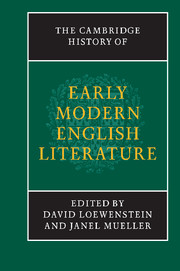Book contents
- Frontmatter
- Introduction
- 1 Modes and means of literary production, circulation and reception
- 2 The Tudor era from the Reformation to Elizabeth I
- 3 The era of Elizabeth and James VI
- 10 Literature and national identity
- 11 Literature and the court
- 12 Literature and the church
- 13 Literature and London
- 14 Literature and the theatre
- 4 The earlier Stuart era
- 5 The Civil War and Commonwealth era
- Chronological outline of historical events and texts in Britain, 1528–1674, with list of selected manuscripts
- Select bibliography (primary and secondary sources)
- Index
- References
14 - Literature and the theatre
from 3 - The era of Elizabeth and James VI
Published online by Cambridge University Press: 28 March 2008
- Frontmatter
- Introduction
- 1 Modes and means of literary production, circulation and reception
- 2 The Tudor era from the Reformation to Elizabeth I
- 3 The era of Elizabeth and James VI
- 10 Literature and national identity
- 11 Literature and the court
- 12 Literature and the church
- 13 Literature and London
- 14 Literature and the theatre
- 4 The earlier Stuart era
- 5 The Civil War and Commonwealth era
- Chronological outline of historical events and texts in Britain, 1528–1674, with list of selected manuscripts
- Select bibliography (primary and secondary sources)
- Index
- References
Summary
Although the Reformation is often blamed for suppressing popular drama, and did indeed become a potent oppositional force to be reckoned with in the later sixteenth and early seventeenth centuries, that opposition was by no means evident at first. In Scotland, for example, surviving evidence from the mid sixteenth century shows that theatrical activity, carried out in open-air public venues, could serve the Protestant cause. In 1571 John Knox watched a play that dramatised the current siege of Edinburgh Castle ‘according to Mr Knox doctrin’. Although the texts for this and a number of other such plays do not survive, we do have a full text and records of performance of Sir David Lindsay’s Ane Satyre of the Thrie Estaits, staged first in 1540 before the King and Queen at Linlithgow, then at Cupar, Fife, in 1552, and finally at the public playfield in Edinburgh in 1554 in the presence of Marie de Lorraine, Queen Regent, along with ‘ane greit part of the Nobilitie’ and ‘ane exceding greit nowmer of pepill’. Its avowedly political allegory invites John the Common-Weill to take part in a thoroughgoing redistribution of political responsibility and thereby rescue the King (Rex Humanitas) and his three Parliamentary ‘estaits’ (Spiritualitie, Temporalitie and Merchand), from those whose loyalties are ‘speciallie vnto the Court of Rome’ (line 286). The King’s tempters are variously named Sensualitie, Flatterie, Falset and Dissait, until, as often happens in such morality drama, they adopt the disguise names of Devotioun, Sapience and Discretioun.
- Type
- Chapter
- Information
- The Cambridge History of Early Modern English Literature , pp. 428 - 456Publisher: Cambridge University PressPrint publication year: 2003

